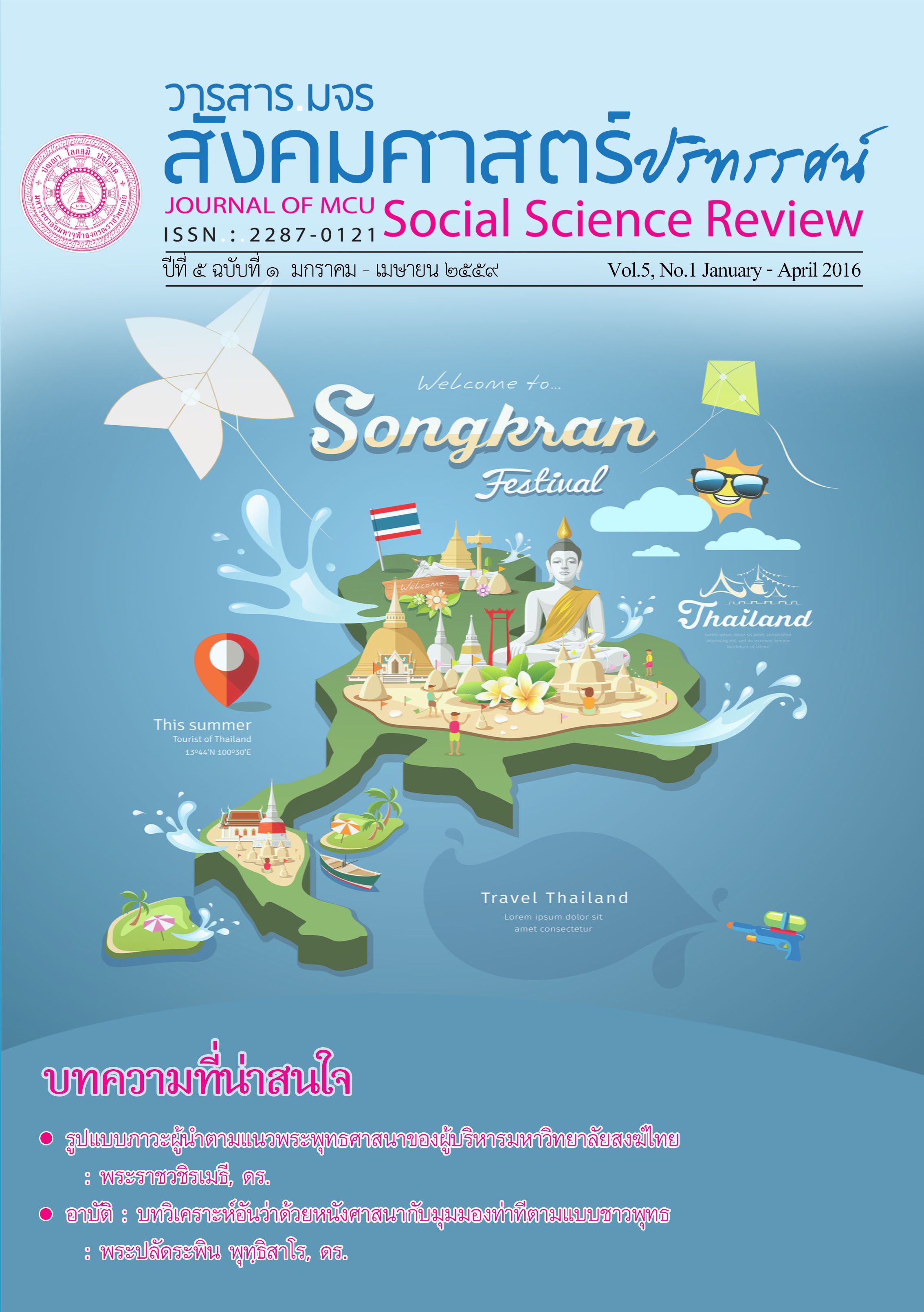กลยุทธ์การพัฒนาทรัพยากรมนุษย์เชิงพุทธ ขององค์กรปกครองส่วนท้องถิ่นในจังหวัดกำแพงเพชร
คำสำคัญ:
กลยุทธ์, การพัฒนาทรัพยากรมนุษยบทคัดย่อ
บทความวิจ้ฉบันี้ มีวัตถุประสค์เพีอ ด) ศึกษาวิเคราะห์สภาพทั่วไปและปัญหาอุปสรรคของการพัฒนทรัพยากมนุษย์ขององค์กรปกครองส่วนท้องถิ่นในจังหวัดกำแพงเพชร ๒) ศึกษาแนวคิด ทฤษฎี และหลักพุทธรรมที่เกี่ยวกับกลยุทธ์การพัฒนาทรัพยากรมนุษย์เชิงพุทธ ๓) นำเสนอกลยุทธ์การพัฒนาทรัพยากรมนุษย์ชิพุทธขององค์กรปกครองส่วนท้องถิ่นในจังหวัตกำแพงเพชรระเบียบวิธีวิจัยเป็นการวิจัยแบบผสานวิธี (Mixed Methods Research) ระหว่างการวิจัยเชิงคุณภาพและเชิงปริมาณ ซึ่งน้นการวิจัยเชิงคุณภาพเป็นหลักและนำผลการวิจัยเชิงปริมาณมาสนัสนุ (๑) การวิจัยเชิคุณภาพ กำหนดผู้ให้ข้อมูลหลัก ด๘ รูป/คน เลือกแบบเจาะจงจากผู้ทรงคุณวุฒิ ครื่องมือเก็บข้อมูลได้แก่ แบบสัมภาษณ์ชิงลึกที่มีโครงสร้าง เก็บข้อมูลด้วยการสัมภาษณ์เชิงล็ตัวต่ตัว วิคราะห์ข้อมูลด้วยวิธีการพรรณนาความ การสนทนากลุ่มเฉพาะ ผู้ร่วมสนทนากสุม คด รูป/คน อแบบเจาะจง ก็บข้อมูลตัวยการสนทนากลุ่ม วิเคราะห์ข้อมูลด้วยการพรณนาความ (๒) การวิจัยเชิงปริมาณ ก็บข้อมูลด้วยกลุ่มตัวอย่าง ก๕๙ คน จากจำนวนประชาการ ๓,๔๙ คน ต้วยแบบสอบถาม วิคราะห์ข้อมูลโตยใช้สถิติพรรณนา ได้แก่ ค่าความถี่ ค่าร้อยละ ค่าเฉลี่ย และต่ส่วนเบี่ยงเบนมาตรฐานผลการวิจัยพบว่า๑. สภาพทั่ไป ปัญหาและอุปสรรคของการการพัฒนาทรัพยากรมนุษย์ขององค์กรปกครองส่วนท้องถิ่นจังหวัดกำแพงเพชร พบว่า องค์กรไม่มีการจัตปฐมนิเทศหรือจัดพี่เลี้ยงคอยดูแลพนักงานที่เข้าทำงนใหม่ จึงเกิดความขัดแงหางจิตวิทยาหรือเข้าใจสิ่งต่างๆ ผิตไป มีการจัดฝักอบมนอยครั้งอันเนื่องมากจากไม่มีการจัตสรงบประมาณในแต่ละปี แหล่งเรียนรู้หรือมุมวิชาการที่เสริมสร้างบรรยากศ การเรียนรู้ภายในองค์กรมีน้อยมาก หลักจากการศึกษาดูงานบุคลากรไม่ค่อยนำเทคนิค วิธีการใหม่ๆ หรือองค์ความรู้ที่ไต้รับมาประยุกต์ใช้พัฒนาในการปฏิบัติงาน องค์กรไมีสวัสติการหรือจัตงบประมาณให้แก่บุคลกรเข้าศึกษาต่อในระดับสูง ส่วนมากจะให้ออกค่าใช้จ่ายโดยใช้ทุนทรัพย์ส่วนตัว๒. ทฤษฎีและหลักพุทธธรรมที่เกี่ยวข้องการพัฒนาทรัพยากรมนุษย์เชิงพุทธขององค์กรปกครองส่วนท้องถิ่นจังหวัดกำแพงพชร พบว่า ทฤษฎีที่เกี่ยวข้องกับการพัฒนาทรัพยากรมนุษย์ได้แก่ รูปแบบการพัฒนาบุคลครตามแนวดิตของสถาบันพัฒนาข้ราชการพลเรือน สำนักงานคณะกรมการข้าราชการพลเรือน ๕ ต้าน คือ ๑) การปฐมนิเทศ การแนะนำชี้แจงให้ทราบความรู้ทั่ไป กฎ ระเบียบ ข้อบังคับ ตลอตจนโครงสร้างขององค์กร ๒) การฝึกอบรม กระบวนการพัฒนาตวามรู้ ความเข้าไ ทักษะและการเปลี่ยนเจตคติของบุคลากร ๓) การส่งศริมวิชาการ การส่งเสริมให้บุคลกรมีความรู้กว้างขวางยิ่งขึ้น และสามารถทำงานได้หลากหลายรูปแบบ ๔) การศึกษาดูงานการเพิ่มพูนความรู้ของบุคลากรให้มีความรู้ความสมารถทันต่อโลกาภิรตน์ และ ๕) การศึกษ์ต่อเป็นการพัฒนาบุคลากรให้มีความรู้ใหม่หรือเพิ่มเติมความเดิมที่มีอยู่ ส่วนหลักพุทธธรรมที่เกี่ยวข้องกับการพัฒนาทรัพยากรมนุษย์ ได้แก่ หลักภาวนา ๔ คือ ค) กายภาวนา การรักษาสุขภาพร่างกายให้แข็งแรงปราศจกโรคอันไม่พึงประสค์ ๒) สีลภาวนา มีความประพฤติเรียบร้อย อยู่ร่วมกันกับผู้อื่นได้ด้วยตี ๓) จิตตภาวนา การมีสุขภาพจิตดี มีจิตสาธารณะ มองโลกในแง่ดี มีความอดทน อดกลั้น และ ๔) ปัญญภาวนา มีความใฝรู้ใฝเรียน เข้าใจ ทุกอย่างตามความเป็นจริง๓. กลยุทธ์การพัฒนาทรัพยากรมนุษย์ชิงพุทธขององค์กรปกครองส่วนท้องถิ่นจังหวัดกำแพงเพชร พบว่า กลยุทธ์การพัฒนาทรัพยากรมนุษย์เชิงทุทธมี ๕ กลยุทธ์ ตังนี้ ๑) การปฐมนิเทศเชิงพุทธ มีกิจกรรมการแนะน้องก่อนทำ (The Worker Care) บุคคสาภิบาล และเข้าวัตขัดใจ ๒)การฝึกอบรมชิงทุทธ มีกิกรมพุทธมามะกะ และการปฏิบัติธรรมสัญจร ๓) การส่งเสริมด้านวิชาการเซิพุทธ มีการจัตตังคสินิก ให้คำปรึกษาเชิพุทธบูรณาการ การจัตบอร์ตธรรมะน่ารู้และเครือข่ายความรู้ทางสังคม (Socail Knowledge Network : SKN), ๔) การศึกษาตงานเชิงพุทธมีกิจกรรมพุทรจาริ นพระสัญจร และพุทธภูมิออนทัวร์ และ ๕) การส่งเสริมการศึกษาต่อเชิงพุทธ มีกิกรรมการธรรมะศึกษาชันเดย์ศึกษาหล้พุทธธรรมบูรณาการกับศาสตร์สมัยใหม่ และการเรียนธรรมะออนไลน์ (E- Leanning)
เอกสารอ้างอิง
กรมส่งเสริมกรปกครอท้องถิ่น. แผนกลยุทธ์การบริหารทรัพยากรบุคคลกรมส่งเสริมการปกครองท้องถิ่นประจำปีงบประมาณพ.ศ.๒๕๕๐. กรุงเทพมหานคร: กรมส่งเสริม
การปกครองท้องถิ่น, ๒๕.๕๐.
ประเวศน์ มหารัตน์สกุล. การจัดการทรัพยากรมนุษย์. กรุงเทหมหานคร : สมาคมส่งเสริมเกตโนโลยีไทยญี่ปุ่น, ๒๕๔๗.
(๒) วิทยานิพนธ์ :
ขวัญฟ้า รังสิยานนท. "การพัฒนรูปแบการจัดกระบวนการเรียนรู้แนวพุทธสำหรับเด็กปฐมวัย"ปรัชญาดุษฎีบัณฑิต (สังคมวิทยา). บัณฑิตวิทยาลัย : มหาวิทยาลัยรามคำแหง,๒ ๕๕๒.
ฐิติวรรณ สินธุ์นอก. การพัฒนาหลัสูตรฝีกอบรมสมรรถนะที่จำเป็นของผู้จัตการฝึกอบรมสำหรับองค์กรเอกชนในประทสไทย . ดุษฎีนิพนธ์. บัณติตวิทยาสัย มหาวิทยาลัยรามคำแหง,๒๕๕๒.
ฌาน ตรรกวิจรณ์. "การพัฒนาทรัพยากมนุษย์ชิงพุทธ". วิทยานิพนธ์ปรัชญาดุษฎีบัณฑิต(สาขาวิชารัฐประศาสนศาสตร์). บัณฑิตวิทยาสัย : มหาวิทยาสัยรามคำแหง,๒๕๕o.
(๓) วารสาร/หนังสือพิมพ์/อินเตอร์เน็ตะ
พระธรรมปิฎกป.อ. ปยุตโต)หัวใจพระพุทธศาสนา. พุทธจักร. ปีที่ ๖ต ฉบับที่ ๕ (พฤษภาคม๒๕๕o).จันทร์ศรี สีลชินาเวศ. การพัฒนบุคลากร. ภาควิชาบริหารธุรกิจ คณะวิทยาการจัตการและ
สารสนเทศศสตมหาวิทยาลัยนรศวร จ.พิษณุโลก.[ออนไลน์].แหล่งข้อมูล :http://www.mis.nu.ac.th/ sharing/prof/junsri2.php[1 มกราคม 2558].
๒. ภาษาอังกฤษ :
(I) Book:
Bowditch. James L. and Buono. Anthony F. A Primer on Organizational Behavior.New York : John wiley and Sons, 1990.
C. Gopinath and Julie Siciliano. Strategize Experiential Exercises in StrategicManagement. 2nd ed. Ohio : Thomson South-Western, 2005.
ดาวน์โหลด
เผยแพร่แล้ว
รูปแบบการอ้างอิง
ฉบับ
ประเภทบทความ
สัญญาอนุญาต
ลิขสิทธิ์ (c) 2016 วารสาร มจร สังคมศาสตร์ปริทรรศน์

อนุญาตภายใต้เงื่อนไข Creative Commons Attribution-NonCommercial-NoDerivatives 4.0 International License.
เพื่อให้เป็นไปตามกฎหมายลิขสิทธิ์ ผู้นิพนธ์ทุกท่านต้องลงลายมือชื่อในแบบฟอร์มใบมอบลิขสิทธิ์บทความให้แก่วารสารฯ พร้อมกับบทความต้นฉบับที่ได้แก้ไขครั้งสุดท้าย นอกจากนี้ ผู้นิพนธ์ทุกท่านต้องยืนยันว่าบทความต้นฉบับที่ส่งมาตีพิมพ์นั้น ได้ส่งมาตีพิมพ์เฉพาะในวารสาร มจร สังคมศาสตร์ปริทรรศน์ เพียงแห่งเดียวเท่านั้น หากมีการใช้ภาพหรือตารางหรือเนื้อหาอื่นๆ ของผู้นิพนธ์อื่นที่ปรากฏในสิ่งตีพิมพ์อื่นมาแล้ว ผู้นิพนธ์ต้องขออนุญาตเจ้าของลิขสิทธิ์ก่อน พร้อมทั้งแสดงหนังสือที่ได้รับการยินยอมต่อบรรณาธิการ ก่อนที่บทความจะได้รับการตีพิมพ์ หากไม่เป็นไปตามข้อกำหนดเบื้องต้น ทางวารสารจะถอดบทความของท่านออกโดยไม่มีข้อยกเว้นใดๆ ทั้งสิ้น





